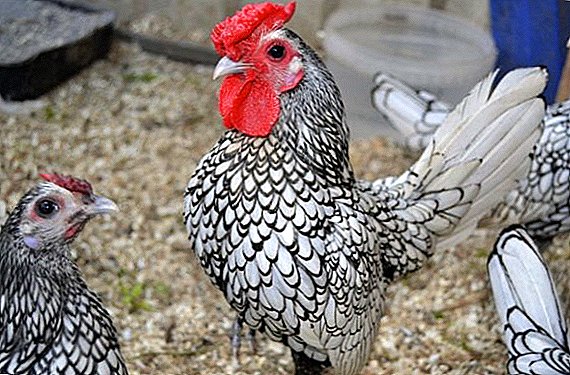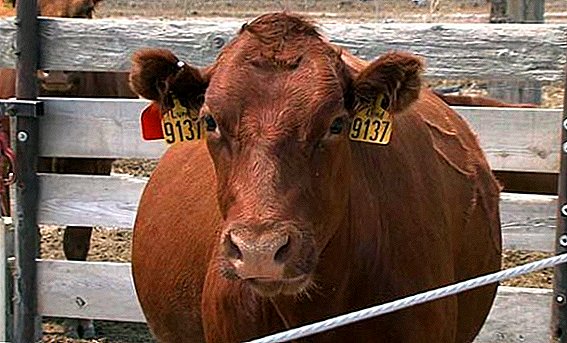 Unfortunately, quite often cattle are exposed to various diseases that can be fatal or the need to destroy all livestock. That such a disease is anthrax. In this article we will talk about the forms of the disease, its symptoms and methods of treatment.
Unfortunately, quite often cattle are exposed to various diseases that can be fatal or the need to destroy all livestock. That such a disease is anthrax. In this article we will talk about the forms of the disease, its symptoms and methods of treatment.
What is this disease
Anthrax is an infectious disease, which is characterized by signs of septicemia and severe formation of carbuncles. The disease can affect all domestic and wild animals.
It is characterized by a very rapid spread and in most cases leads to the death of the animal. The source of infection is not only the sick individual, but also the soil in which the pathogen can live for several years.
History reference
The first mention of this disease appeared before our era. The disease was called the ancient Arab physicians as the "Persian fire", and in ancient Greece and ancient Rome, the disease was called the "sacred fire".
Important! Due to the fact that young animals still have an immature immunity, its infection occurs more often than in adults. It is for this reason that all calves should be vaccinated.In the Middle Ages, outbreaks of illness occurred quite often in European countries. According to the annals, anthrax began to appear in Russia since 978, and the strong outbreaks of the disease date back to the XVIII-XIX centuries.
 An important contribution to the study of the disease was made by S. N. Vyshlessky, N. A. Mikhin, F. A. Terentyev, S. G. Kolesov, Ya. E. Kolyakov. Beginning in 1944, the STI vaccine offered by N. N. Ginsburg began to be used for prophylactic purposes. It was based on a weakened, capsular-free strain of the causative agent. In 1956, S. G. Kolesov and other scientists created the aluminum hydroxide vaccine GNKI.
An important contribution to the study of the disease was made by S. N. Vyshlessky, N. A. Mikhin, F. A. Terentyev, S. G. Kolesov, Ya. E. Kolyakov. Beginning in 1944, the STI vaccine offered by N. N. Ginsburg began to be used for prophylactic purposes. It was based on a weakened, capsular-free strain of the causative agent. In 1956, S. G. Kolesov and other scientists created the aluminum hydroxide vaccine GNKI.Causative Agent and Routes of Infection
The causative agent of anthrax is Gram-positive fixed stick. Its reproduction occurs quite rapidly in rooms with air, especially if the air temperature is within + 15 ... +42 ° С.
Familiarize yourself with the symptoms and methods of treatment of various diseases of cattle.
The bacterium is able to maintain viability even in a corpse at the stage of decomposition - it is active for 7 days. Heating to 60 ° C can destroy it in 15 minutes, solar radiation - in a couple of minutes, when boiling it dies immediately. In addition, bacteria can be eliminated using a standard disinfection procedure.
Bacilli are resistant to low temperatures and can survive 10-14 days at -15 ° C. When salting hides and drying meat, the bacteria are stored in the finished product. The main route of infection of cattle is alimentary. Infection by the aerogenic method is rare.  Bacillus Bacillus anthracis Most often it occurs at the time of contact with the soil while eating food that is contaminated by the pathogen, or with water through the mucous membrane of the mouth and digestive tract. In rare cases, a disease can occur through the nasal mucosa, conjunctiva, or damaged skin.
Bacillus Bacillus anthracis Most often it occurs at the time of contact with the soil while eating food that is contaminated by the pathogen, or with water through the mucous membrane of the mouth and digestive tract. In rare cases, a disease can occur through the nasal mucosa, conjunctiva, or damaged skin.
Did you know? Translated from the Latin anthrax bacillus means: "bacillus" - bacillus, "anthrax" - coal. This is due to the fact that the scab, which appears during the illness, because of its black color, looks very similar to the coke.
Rarely and intrauterine infection. Transmission of anthrax can occur through transmission. In the summer, with the help of arthropods, which suck the infected blood of animals, the illness can be transported over long distances.
Forms
There are several forms of the disease, consider them in more detail.
Septic
In this form, there is a rapid increase in body temperature to 40 degrees, and sometimes higher. Unfortunately, most likely, by this time the bacteria had already spread throughout the body, entering the bloodstream.  There may be symptoms of pneumonia, hemorrhagic pulmonary edema, sometimes the brain becomes inflamed, peritonitis develops, and intestinal bleeding may occur. The death of the animal occurs 1-3 days after the active development of the disease. Some subforms are also identified, in which the lesion is localized in a specific place.
There may be symptoms of pneumonia, hemorrhagic pulmonary edema, sometimes the brain becomes inflamed, peritonitis develops, and intestinal bleeding may occur. The death of the animal occurs 1-3 days after the active development of the disease. Some subforms are also identified, in which the lesion is localized in a specific place.
These include:
- respiratory. All symptoms point to acute pneumonia that develops into pulmonary edema over time;
- anginal. It is characterized mainly by hidden flow. Body temperature remains unchanged, it is difficult for an animal to swallow food, cough begins, wheezing appears. The throat may swell severely, which will impede the access of oxygen;
- intestinal. The intestines are affected, constipation is noted, after which a bloody stool appears, which can trigger the appearance of intestinal paresis or peritonitis.
Read more about what drugs are needed for the treatment of cattle.
Kurbunkuloznaya
The appearance of the skin form is diagnosed in 90% of cases of the disease. Most often, it manifests itself in the place where the body struck the pathogen, it can also act as a secondary factor if an acute or septic disease course is present.
Those areas of the skin that were affected are covered with swelling, they feel hard and hot to the touch. While touching them, the animal hurts.  After some time, there is a decrease in body temperature in the swollen areas, in some cases it is even lower than it should be normal. There is a dying off of tissue from the center, instead of them, a round ulcer is formed, which is colored black. Also note a slight increase in overall body temperature.
After some time, there is a decrease in body temperature in the swollen areas, in some cases it is even lower than it should be normal. There is a dying off of tissue from the center, instead of them, a round ulcer is formed, which is colored black. Also note a slight increase in overall body temperature.
Symptoms and course of the disease
In order to diagnose the disease in a timely manner, it is important to know what symptoms are peculiar to it and how it can occur.
Lightning fast
The development of this type of anthrax occurs very quickly, and animals can die suddenly. The ability to identify the disease and its treatment is missing.
Important! After taking blood from the ear of a dead animal for histology, the smear site must be cauterized so that the infection does not spread further.The fulminant course of the disease has the following symptoms:
- body temperature rises sharply to 41 degrees;
- there are sharp bouts of excitement in cattle, which is replaced by complete apathy;
- the pulse and breathing quickens, the cow is breathing heavily;
- the mucous membrane becomes bluish.
As a result of the defeat of such a form of a cow dramatically fall on the ground, death occurs in convulsions. After the lethal outcome has occurred, a bloody foam appears near the nostrils and mouth. 
Sharp
The development of this form occurs measuredly. It is possible to determine the symptoms in time and proceed to therapeutic measures.
It will be helpful for you to read about how to treat such infectious diseases as chlamydia, bluetongue, necrobacteriosis, smallpox, brucellosis, leptospirosis, malignant fever, anaplasmosis, parainfluenza-3 and actinomycosis.
The main signs of acute anthrax:
- the presence of rapid breathing and intense heartbeat;
- body temperature rises to 42 degrees;
- swelling of the scar;
- appetite decreases, and the animal can completely refuse food;
- in the mammary gland stops the formation of milk;
- the appearance of bloody stools and blood in the urine;
- mucous membranes become bluish, they show the appearance of point lesions;
- there is severe swelling of the throat or abdomen.
The death of an animal can occur in 2-3 days, the cows suffer in convulsions.
Subacute
It is characterized by the same symptoms as the first two cases. However, in the presence of a subacute course of illness, death may occur within a week after infection. It is worth paying attention to the fact that from time to time the signs recede, which can be misleading and complicate the diagnosis of the disease. 
Chronic
The signs of anthrax with this type of leakage are quite erased, but it is difficult not to notice that the depletion of animals is gradually increasing. The disease can last 2-3 months. First it is necessary to discard the animals, then slaughter, and after that, under the jaws, there are muscles in which there is hemorrhagic gelatinous content. Regional lymph nodes may also be inflamed.
Diagnostics
Diagnostics involves a whole range of activities. The first thing you need to pay attention to the symptoms. Most often, carbuncles appear on the skin. In addition, the abrupt death of animals begins to take place after a new pasture has been selected for grazing, next to which there are building sites or landslides.
Did you know? Anthrax bacteria spores can persist in the soil for up to 100 years.
At the first suspicion of anthrax, you should immediately contact a veterinarian. In such a situation, it is imperative to conduct laboratory tests, for which it is necessary to take the blood of an infected or killed individual. A pathogen will be isolated from blood and a pure culture will be grown using a nutrient medium.  In the presence of samples of the skin of the deceased animal practice research, based on the precipitation reaction. With this method, the microbe can be detected, even if it cannot be seen with a microscope.
In the presence of samples of the skin of the deceased animal practice research, based on the precipitation reaction. With this method, the microbe can be detected, even if it cannot be seen with a microscope.
Another effective diagnostic method is the introduction of an allergen through the skin. If there is a reaction, we can say that the pathogen is present in this individual. In such a situation it is necessary to close the farm and declare quarantine.
Pathological changes
If there is a suspicion that a disease such as anthrax is present, it is strictly forbidden to perform an autopsy. The decomposition of the corpses of sick individuals occurs quickly, they are characterized by bloating, rigor mortis, or it is not very pronounced. Blood fluid or blood can be released from the openings.
Important! It is possible to remove quarantine no earlier than 15 days after the last death of animals or after their final recovery. At the same time, there must be no reaction to vaccination.
Most often, swelling may be observed in the submandibular space, neck, dewlap, abdomen. The blood has a dark color and does not coagulate. There is an increase in lymph nodes, spleen, the presence of serous and hemorrhagic exudate in the sternum and abdominal cavity.  The animal has a flabby liver, hemorrhages are noted in the kidneys. There are pulmonary edema. If the death of the animal occurred during the lightning-fast course of the disease, then there may be no characteristic changes for this ailment.
The animal has a flabby liver, hemorrhages are noted in the kidneys. There are pulmonary edema. If the death of the animal occurred during the lightning-fast course of the disease, then there may be no characteristic changes for this ailment.
Methods of struggle and quarantine
In most cases, it is impossible to save an infected animal, but subject to the presence of strong immunity, some therapeutic measures can be taken.
It is imperative that sick cows be isolated and allowed to perform the following actions:
- intravenously deliver a specific hyperimmune serum of 100-200 ml per individual. To avoid anaphylactic shock, first inject 1 ml, and after 30 minutes everything else. It is important that the temperature of the drug was 37-38 degrees. If the body temperature of the animal does not drop, after 12 hours, they repeat the medication;
- give the animal antibiotics, such as "Penicillin" or "Streptomycin". Introduce them intramuscularly three times a day at the rate of 500 thousand IU for every 100 kg of body weight. The interval between the introduction should be 4 hours, and after improving the condition of individuals, it can be increased to 6 hours.
In order to prevent the spread of disease, you should definitely:
- enter quarantine;
- put in the veterinary service on the registration of areas with foci of the disease;
- immunize regularly for prophylaxis;
- dead bodies of diseased individuals, as well as burn manure and feed.
 After the quarantine is lifted, it is necessary to draw up an act that includes all the activities carried out in this territory. It should contain the places where the dung is located, as well as the places where the corpses were burned.
After the quarantine is lifted, it is necessary to draw up an act that includes all the activities carried out in this territory. It should contain the places where the dung is located, as well as the places where the corpses were burned.Can a person get infected
Infection of a person by illness occurs during contact with a sick individual or with the help of raw materials or processed products. Microbes can enter the human body through the skin, if they are scratched and damaged, when in contact with infected cows, animal skins or blood at the time of slaughter.
For care of cows, it will be important for you to know about how cows are kept, as well as which breeds of cows are among the best, how much the cow weighs on average, how to milk a cow, how to process the udder before and after milking, why it is important to trim the hooves of the cows .
In this case, a person will become infected with a skin form, and anthrax will manifest itself in the form of the appearance of carbuncles on the skin. If an infection has occurred by eating infected products, then a person is diagnosed with an intestinal form, but this happens quite rarely.
In large productions, spores of the disease can be transmitted to humans by aerogenic means, and then they talk about a pulmonary form of leakage. Most often, the incidence rate of people becomes higher during the period when animals are ill - from July to September.
Video: transmission, symptoms and treatment of anthrax
Prevention and anthrax vaccine for cattle
Prevention of the emergence and spread of anthrax includes the following activities:
- Bovine vaccination should be regularly carried out in both private and industrial farms. It is very important to implement it in areas where outbreaks of the disease have already been recorded;
- it is necessary to identify, keep records and eliminate the foci of infection in the layers of the soil;
- periodically veterinary checks should be carried out, meat and dairy products should be examined for the presence of microbes;
- disinfection should be carried out periodically in rooms, walking areas, and livestock yards using sodium hydroxide;
- after the death of animals, they are burned with manure, bedding and other materials;
- the soil on which the animals were burned and the floor in the barn must be treated. To do this, use a solution of caustic soda or formaldehyde, which is heated to a hot state.
We advise you to get acquainted with the top 10 interesting facts about cows.
Vaccinations in regions considered to be adverse should be carried out every year. If there is an immediate threat of disease, bovine immunization is carried out every six months. Immunization of calves is carried out for the first time at the age of 12-14 weeks and then once in 6 months. 
Most often for vaccination use a lyophilized biological product 55-VNIIVViM. The drug is injected subcutaneously using a needleless injector. The formation of antibodies in the animal's body occurs on the 11th day, and immunity can persist for 12 months.
Did you know? The largest outbreak of anthrax among people in the XX century was registered in 1979 in Sverdlovsk - then 40 people died from the disease.Anthrax is a very serious disease that carries a threat not only to cattle, but also to humans. It is for this reason that farmers should carefully monitor the state of health of animals and at the first suspicion of the presence of the disease immediately contact the veterinary service.












